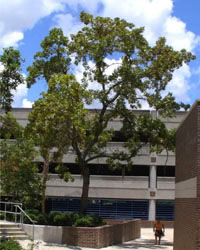Quercus laevis - Turkey oak



Family Fagaceae
Description:
About 600 species of oaks can be found around the world, mostly in the northern hemisphere. Turkey oak is the common scrub oak in dry areas of campus. Turkey oak leaves have three to five deep lobes. The leaves turn dark red in winter and are held after turning brown well into the winter. The branching and crown shape are irregular compared to popular shade tree species. Trees are too small and slow growing for commercial timber use but the wood is a valuable for fuel. Bark and branches have been used as a source of tannin. The acorns are an important food for black bear, deer and other wildlife.
Location:
See these plants throughout campus, especially in higher, drier sites.
Size:
Medium sized tree to about forty feet tall or more.
Care Instructions:
Light: full sun
Water: very drought tolerant
Soil: well-drained, no other special requirements
Turkey oak grows best in a sunny site in a well-drained soil in areas with little competition from other trees. This native tree is hard to find in nurseries but is worth keeping where it occurs naturally.
